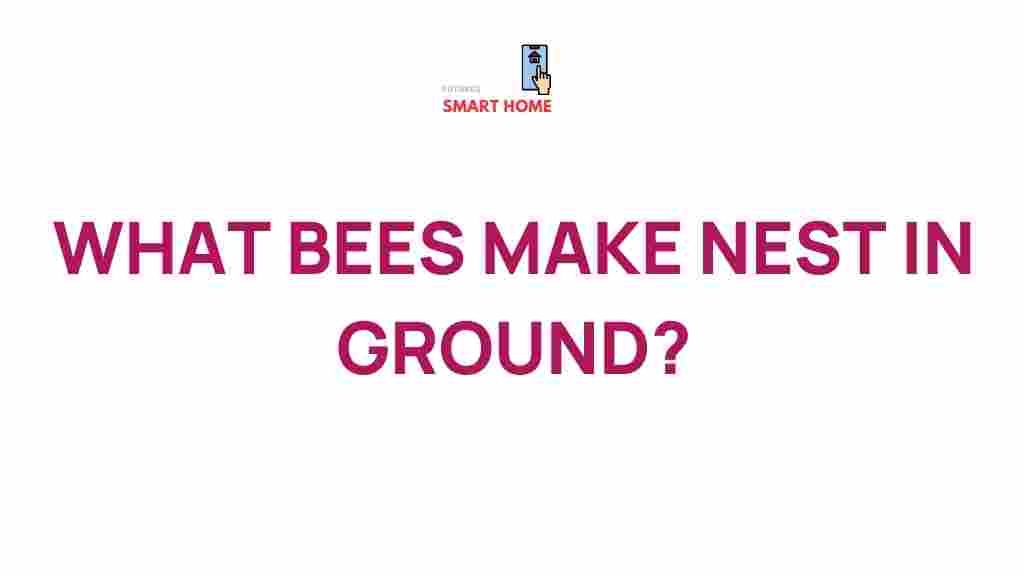Uncovering the Fascinating World of Ground-Nesting Bees
Bees are some of the most essential pollinators in our ecosystems, playing a crucial role in the reproduction of many flowering plants. Among the diverse array of bee species, ground-nesting bees hold a particularly significant place due to their unique behaviors and habitat preferences. Understanding these remarkable insects can help us appreciate their contribution to biodiversity and the need for conservation efforts.
The Importance of Ground-Nesting Bees
Ground-nesting bees, as the name suggests, create their nests in the soil rather than in trees or other structures. This nesting behavior is found in many species of bees, including some of the most effective pollinators. Here’s why they are vital:
- Pollination: Ground-nesting bees are exceptional pollinators, helping to fertilize plants and increase crop yields.
- Biodiversity: They contribute to the overall health of ecosystems by supporting various plant species.
- Soil Health: Their nesting activities can enhance soil aeration and nutrient cycling.
Understanding Their Habitat
Ground-nesting bees thrive in diverse habitats, which include:
- Open Fields: These areas provide unobstructed access to flowers.
- Grasslands: Ground-nesting bees often prefer areas with low vegetation where they can easily dig.
- Urban Gardens: Even in cities, ground-nesting bees can find suitable nesting sites in gardens and parks.
Each of these habitats supports different species of ground-nesting bees, which have adapted to their environments over time.
Species of Ground-Nesting Bees
There are numerous species of ground-nesting bees, each with unique characteristics and behaviors. Some of the most notable include:
- Andrena (Mining Bees): These bees are solitary and often have a short lifespan, emerging in spring to pollinate early-blooming flowers.
- Colletes (Plasterer Bees): Known for their unique nesting habits, they create nests that are plastered with a mud-like substance.
- Lasioglossum (Sweat Bees): These bees are often attracted to human sweat and are known for their small size and metallic coloring.
Each species plays a specific role in the ecosystem, highlighting the importance of conserving their populations.
The Life Cycle of Ground-Nesting Bees
The life cycle of ground-nesting bees generally includes the following stages:
- Egg: After mating, females lay eggs in the nest, often alongside stored pollen for nourishment.
- Larva: The eggs hatch into larvae, which consume the pollen and nectar until they are ready to pupate.
- Pupa: Larvae undergo metamorphosis in the pupal stage, where they develop into adult bees.
- Adult: New adult bees emerge from the nest, ready to begin the cycle again.
This life cycle underscores the importance of suitable habitats for their survival, as they rely on specific conditions to thrive.
Challenges Facing Ground-Nesting Bees
Despite their ecological importance, ground-nesting bees face numerous challenges:
- Habitat Loss: Urbanization and agricultural expansion often lead to the destruction of natural habitats.
- Pesticides: The use of harmful chemicals can adversely affect bee populations and their health.
- Climate Change: Changes in temperature and weather patterns can disrupt their life cycles and habitats.
Addressing these issues is crucial for the conservation of ground-nesting bees and, by extension, biodiversity.
Conservation Efforts for Ground-Nesting Bees
To protect ground-nesting bees, various conservation strategies can be implemented:
- Creating Bee Habitats: Planting native flowering plants and minimizing lawn areas can provide essential nesting sites and food sources.
- Reducing Pesticide Use: Opting for organic farming methods and natural pest control can help safeguard bee populations.
- Educating the Public: Raising awareness about the importance of bees can inspire community action towards conservation.
For more detailed information on how to support bee populations, visit the Bee Conservancy website.
Step-by-Step Guide to Creating a Ground-Nesting Bee Habitat
Creating a welcoming environment for ground-nesting bees can be a rewarding endeavor. Here’s a simple guide to get you started:
- Choose the Right Location: Look for sunny, dry areas with well-drained soil, away from heavy foot traffic.
- Prepare the Soil: Loosen the soil with a garden fork to create a suitable nesting environment, avoiding the use of chemicals.
- Plant Native Flowers: Select a variety of native plants that bloom at different times to provide a continuous food source.
- Leave Bare Ground: Ensure there are patches of bare soil for bees to dig their nests.
- Limit Disturbance: Try to keep the area free from heavy machinery and foot traffic during the nesting season.
By following these steps, you can create a thriving habitat that supports ground-nesting bees and the greater ecosystem.
Troubleshooting Common Issues
Sometimes, efforts to attract ground-nesting bees may not yield immediate results. Here are some troubleshooting tips:
- Monitor Plant Growth: Ensure that the native plants are thriving and producing flowers.
- Check Soil Conditions: If the soil is too compacted or wet, consider aerating it or improving drainage.
- Avoid Disturbing Nests: If you notice ground-nesting bees, try not to disturb them, as this can drive them away.
Patience is key; creating a welcoming habitat may take time, but the benefits to local biodiversity are invaluable.
Conclusion
Ground-nesting bees are vital pollinators that contribute to biodiversity and the health of our ecosystems. By learning more about their habitats, life cycles, and the challenges they face, we can take meaningful steps toward conserving these incredible insects. Whether through creating habitats or advocating for reduced pesticide use, every action counts in supporting ground-nesting bees and ensuring they thrive for future generations.
For additional resources on bee conservation, check out the Pollinator Partnership website.
This article is in the category News and created by FutureSmarthome Team
